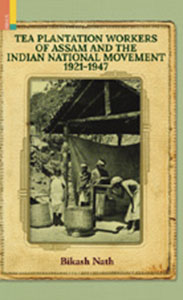
Tea Plantation Workers of Assam and the Indian National Movement, 1921-1947
AUTHOR : Bikash Nath
| HB ₹1950 . $84.95 . £56.95 |
e-Book ₹1745 . $76.95 . ₤49.95 |
|
INFORMATION
- AUTHOR : Bikash Nath
- HB ISBN : 978-93-84082-62-8
- EBOOK ISBN : 978-93-84092-18-4
- Year : 2016
- Extent : 380 pp.
- Discount available on checkout
- Usually dispatched within 3 to 5 working days.
Tagore
| HB ₹ 995 . $ . ₤ |
PB ₹ . $ . ₤ |
|
| POD ₹ . $ . ₤ |
e-Book ₹ . $ . ₤ |
INFORMATION
- AUTHOR –
- ISBN – 978-93-84082-78-9
- Year – 2016
- Extent: 400 + 40 coloured illustrations
- 10% discount + free shipping
- Usually dispatched within 3 to 5 working days.
This book studies various phases of workers’ politics in the tea plantations of Assam and deliberates upon the role of nationalist leaders in moulding the fate of these workers. The struggles of tea plantation workers were a manifestation of the strength of their protests against varied forms of exploitations of the tea planters. Their struggle occurred at the time of the formation of the indigenous bourgeoisie, and continued despite the
nationalist leadership not providing sufficient support to them. The deep incongruity between interests of the workers and of the nationalist leadership largely determined the fate of the material conditions of these labourers. This book dwells on these and related issues in delineating the history of nationalism amongst the tea plantation workers of Assam
The Editor
Bikash Nath is Assistant Professor of History, C.K.B. College, Teok Jorhat, Dibrugarh University, Assam. He has published several research articles in national and international journals.
As a global figure, Tagore transcends the boundaries of language and reaches out to people distant both in time and space. His art took inspiration from contemporary Western trends and became a powerful means to connect with people beyond Bengal. Word, image, song, and text were his tools of communication, as also his extraordinary presence in a sartorial garb of his own design. A littérateur in many genres, the impact of his work was determined both by the material he presented, and by its simultaneously local and global contexts. Now, when his international reputation has spanned over more than a hundred years, it is important to revisit the sites of Tagore’s eminence, and ask to what extent he was a ‘living text’ in the century that witnessed him as a global intellectual.
Accordingly, this volume investigates how Tagore’s writings and art are linked to the metalinguistic domains of the psychological, medical and mythical; how he was received in various cultures outside India; how his art was determined by individual circumstances and global aspirations; and how he acted as an inspiration to his contemporaries and subsequent generations including modern Indian writers and artists.
The Editor
Imre Bangha studied in Budapest and Santiniketan and at present is Associate Professor of Hindi at the University of Oxford. He has published books and essays in English, Hindi, and Hungarian on literature in Brajbhasha and other forms of old Hindi and has also prepared Hungarian translations from various South Asian languages. His work on the international reception of Bengali culture includes Rabindranath Tagore: Hundred Years of Global Reception (2014, co-edited with M. Kämpchen) and Hungry Tiger: Encounter between India and Central Europe (2007).
Table of Contents
| List of Tables | vii |
| Preface | ix-xiii |
| Acknowledgements | xv-xvii |
| Abbreviations | xix-xx |
| 1. Introduction | 1-49 |
| 2. Development of the Tea Industry and the Emergence of an Industrial Working Class in Assam: A Historical Overview | 50-107 |
| 3. The Formation of the Indigenous Tea Capitalists and their Nationalist Roots | 108-145 |
| 4. L abour on Protest: Gandhi, the Non-Cooperation Movement and its Impact, 1920-1922 | 146-177 |
| 5. The Depression, the Tea Industry and the Workers’ Struggle, 1930-1939 | 178-227 |
| 6. Trade Unionism in Assam: The Left and the Tea Plantation Workers | 228-268 |
| 7. The Plantation Workers’ Struggle: The Final Phase, 1939-1947 | 269-301 |
| 8. Conclusion | 302-310 |
| Appendices | 311-328 |
| Glossary | 329-330 |
| Bibliography | 331-343 |
| Index | 345-360 |




